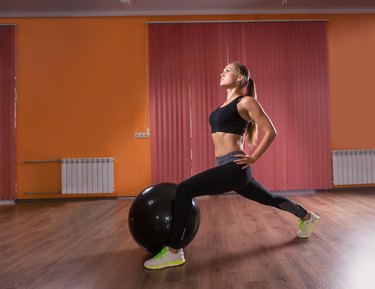
Many people, especially women, tend to store weight in their lower bodies, which makes the thighs a common "trouble zone." How easily you can lose an inch off your thighs depends on your current fitness level -- if you're currently overweight, you'll be able to lose that inch relatively easily by losing body fat. If you're already thin and fit, however, you'll likely need to work harder to lose that inch.
Lose Body Fat for Smaller Thighs
Video of the Day
Reducing your body fat will help you take an inch off your thighs. You can't lose fat specifically from your thighs, but as you lower your overall fat levels, your thighs will shrink proportionally to the rest of your body. Safe, sustainable weight loss comes at a rate of roughly 1 to 2 pounds weekly, and you can achieve it by eating 500 to 1,000 fewer calories than you burn daily.
Video of the Day
If you have a significant amount to lose, aim for weight loss at the higher end of that spectrum; if you're already at a healthy body weight, aim for 1 pound per week. Use an online calculator to figure out your calorie needs, based on your body size, age, gender and current activity level; then subtract calories accordingly to create your calorie deficit. Just don't go lower than 1,400 calories daily, recommends the University of Michigan, or you'll go into a semi-starvation state that makes it harder to shed body fat.
Make Dietary Changes to Lose the Inch
No matter how many calories you're eating, or the calorie deficit you're aiming for, you should use wholesome, unprocessed foods to make up most of your meals. Lean protein -- the type found in fish, chicken and turkey breast, eggs, nonfat dairy, beans and lentils -- keeps you full and supports muscle growth, while fruits and veggies offer filling fiber, along with vitamins and minerals you need for overall health. Moderate portions of whole grains -- a half-cup per serving -- provide carbs to fuel your workouts, along with fiber to help keep you satisfied.
Ditching processed foods in favor of whole foods has other benefits, too. Processed foods tend to contain large amounts of sodium for flavoring, which can trigger water retention. If you're currently retaining fluid as a result of following a high-sodium diet, simply lowering your salt intake can help you de-bloat and lose some water weight.
Incorporate Thigh-Toning Cardio
Make cardiovascular exercise part of your daily routine to slim down your whole body, including your thighs. Cardio burns calories, so getting active makes it easier to create a calorie deficit, which you'll need to lose weight. How many calories you burn depends on the type of cardio you do, as well as your body weight. For example, a 30-minute low-impact step aerobics class will burn 210 calories if you weigh 125 pounds; 260 calories if you weigh 155 pounds; and, if you weigh 185 pounds, 311 calories. The same length high-impact step aerobics class burns 300, 372 and 444 calories for 125-, 155-, and 185-pound person, respectively.
Most forms of cardio work your legs, so they can help keep your thighs looking fit and toned. Choose a variety of cardio to work your thighs from all different angles. Mix running on the treadmill with using the skating machine at the gym. Alternate rowing or cycling with skiing or rollerblading, and incorporate dance and step classes that work your thighs from all different angles to help them look toned.
Sculpt Your Thighs With Strength Training
Strength training can also help you lose an inch off your thighs. It helps build and maintain lean muscle, so your thighs will look healthy and toned as you drop body fat. Regular-strength workouts also keep some tension in your leg muscles -- think of it as a mild version of flexing -- that make your thighs look firmer. Work your thigh muscles from all angles through different variations of squats, lunges and deadlifts. Perform back, side and curtsy lunges to work your thighs from different angles, and try both standard and sumo squats and deadlifts to challenge the front, back and sides of your thighs.
Make sure you stretch after each workout. Strength training can create a muscle "pump," which temporarily swells your muscles with fluid after your workout, making them appear larger. Stretching helps release this fluid, reducing the "pump" and making your thighs appear smaller. Experiment with forms of exercise that combine thigh-toning moves with stretches, like Pilates and yoga.